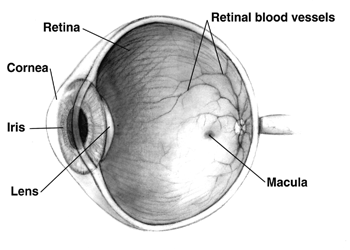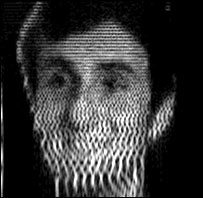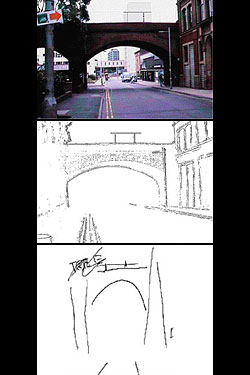
All About the Eye and Vision - Diseases - Wikipedia

System allows blind people to see with their tongue Science Daily - June 2004
'Laser vision' offers new insights BBC - May 2004

'Laser vision' offers new insights BBC - April 2004

A system that projects lasers onto the retina, allowing
users to view images on top of their normal field of vision.
Liquid lens mimics human eye Nature - March 2004
New York: 7-month-old Is Youngest Recipient Of Artificial Corneal Transplant Science Daily - January 2004
Artificial cornea grafts raise eye treatment hopes December 2003 - Ananova
New lens corrects sight problems permanently November 2003 - Ananova
Laser surgery 'improved by eye mapping' - Iris Recognition System November 2003 - Ananova
The Genetics Of Blindness Science Daily - October 2003
Blind 'see with sound' BBC - October 2003

Human eyes can be in two places at once ABC New - July 2003
Students who suspect teachers have eyes in the back of their heads may be right - in a way: researchers have proven for the first time that human eyes can focus on more than one point simultaneously.
The German study, which used a sophisticated computer version of the card game 'snap', asked the 15 subjects to concentrate on a point on a computer screen while four different symbols were also flashed on the screen. They had to press a button when they saw two symbols that matched.
Matthias Muller from the University of Leipzig, who led the study, found that the subjects were able to identify when there were two matching symbols on different parts of the screen.
This result helps to answer a long-standing controversy about whether the 'spotlight' of spatial attention only has one beam, or if it can be divided into several locations. The results are published in this week's issue of the journal, Nature. Previous results of many behavioural and electrophysical studies had supported the single spotlight view. But the new research shows that the brain can simultaneously focus on multiple regions, rather than just rapidly switching its attention between them.
The researchers eliminated the possibility of the subjects quickly alternating their vision between the two symbols by flashing the symbols at a rate of 181 milliseconds (thousands of a second). This is faster than humans can switch between two locations, which has previously been measured at between 200 and 500 milliseconds.
Each of the symbols was flickering at a different rate, which meant the researchers could distinguish symbols from one another using their measuring equipment. The subjects, who were linked up to 30 scalp electrodes on an elastic cap, were able to determine when there were two matching symbols - this demonstrates that human eyes are able to focus on two things at once.
"The present findings provide evidence that the spotlight may be divided for sustained periods. This would appear to be a highly efficient early selection mechanism for distributing attention optimally to dispersed stimuli in the visual surroundings," Muller concluded in his paper.
Eye Movement Studies To Help Diagnose Mental Illness Science daily - June 2003
The Human Eye Can Self-correct Some Optical Faults Science Daily - February 2003
Newborns Know How to Make Eye Contact June 2002 - Yahoo
Futuristic System Brings Vision To Blind Artificial Eye Device - Science Daily June 2002
Eye drops delay glaucoma Eye drops used to treat glaucoma can significantly delay - and possibly stop - the disease developing in the first place, according to a new US study. Look in the eye reveals internal bleeding
Blindsight Can Be Better Than Real Sight Primitive visual pathway that controls behavior without conscious vision
Frogs and humans see eye to eye April 2002 - ABC News - A Japanese embryologist has grown and successfully transplanted artificial frogs' eyes using a type of stem cell.
Correcting Vision April 2002 - New Scientist Magnetic fluid 'could save sight' April 2002 - BBC

The photograph of the bridge, top, was translated into the middle outline and conveyed through music to a blind subject. The subject produced the bottom image of the bridge using the musical description.
October 29, 2000 - AP
Two blind people in England were able to imagine and draw pictures of cars, buildings, landscapes - even a painting by Cezanne - that were all described to them through music.
B.K., a 52-year-old man, and M.S., a 49-year-old woman, both lost their sight over 20 years ago. And yet, by training their ear to listen for images encoded into music, they were able to "see" images in their imagination.
The technique works by using a computer to digitize images and then relay them numerically into musical form. The length of horizontal lines are conveyed by how long a single note is held. Vertical lines are made going up or down the musical scale. The subjects' ears are then trained to hear what a certain line sounded like. For instance, a horizontal line of a certain length that's rising sounds like this, and vert one sounds like that.
"So for example, I had an X, two diagonal bars crossing each other, you'd hear notes going down and up at the same time. They reach a point where they're the same note and then they diverge," said co-author Krisha Persaud said.
The subjects picked up the musical clues very quickly, said John Cronly-Dillon, a neuroscientist at England's University of Manchester and lead author of the study.
"Within five minutes they can do something simple, like a triangle," he said.
The technique wouldn't work on people blind since birth, who have no appropriate reference points in their visual vocabulary.
Distilling complex visual scenes into simple shapes via sound has its origins in artificial intelligence.
"Because you want a computer to recognize a scene, the image is fed into the computer and it creates an internal 'image,'" said neuropsychologist and artificial intelligence expert, Richard Gregory at England's University of Bristol.
"It's not unlike what we do when our brains take in and interpret an image," he said
Pernaud agrees and notes that translating rich, complex images into simple shapes doesn't necessarily limit their functional value.
"It's the same way Picasso did," he said. "Where you can draw a few lines and that could identify an object. So we're not conveying everything there is in vision to a blind person, but we're giving them enough information to actually deal with the world."
The study will be published in the Nov. 7 issue of Proceedings B from Britain's Royal Society.
"Where we're going with this is hooking it all up to video so they can visualize everything immediately," Cronly-Dillon
This would involve attaching video cameras to blind people that would continuously emit sounds corresponding to objects in their environment, allowing them to navigate without help. For example, a manhole would sound like a circle and Christmas tree like a triangle.
Right now, B.K. and M.S. are using the video systems to walk about - albeit very slowly with little shuffling steps, said co-author Krisha Persaud.
June 26, 2000 - AP
Scientists have identified the defective gene that causes a debilitating total color-blindness among many inhabitants of a tiny Pacific island.
The neurologist Oliver Sacks described the condition in the 1997 book "The Island of the Colorblind." The afflicted islanders see the world as if watching it on a black-and-white television.
The discovery of the defective gene ends a 30-year search. Researchers said it will not lead to a treatment immediately but might help find one eventually.
It could also lead to a test to tell islanders with normal vision whether they carry a flawed copy of the gene that would raise their children's risk of color-blindness. The disorder appears only in people who inherit a flawed copy from each parent.
The island, Pingelap, is part of the Federated States of Micronesia. Of the 3,000 Pingelapese, some of whom live on nearby islands, about one in 20 is totally colorblind. That compares with a worldwide rate of one in 50,000.
The flawed gene has been traced back to one man, who was among 20 survivors of a typhoon on Pingelap around 1775 who went on to re-establish the population.
The condition differs from the relatively common color-blindness in which people cannot distinguish certain colors. Affected people on the island cannot see colors at all. They lack the sharp vision most people use to read, and their eyes are overwhelmed by sunlight - a particularly severe problem in the tropics.
In his book, Sacks noted that some affected islanders found work fishing by night.
"They're about as handicapped as you can be," said Dr. Irene Hussels Maumenee, a member of the research team that first formally described the condition on Pingelap in 1970.
"They stay in the cabin all day. They just don't see when they go out in the sunlight," said Maumenee, a professor of ophthalmology and pediatrics at the Johns Hopkins University School of Medicine.
Their difficulty in reading hampers their schoolwork, and "people consider them very much as an outcast," she said.
She is senior author of the paper announcing the finding of the gene, which appears in the July issue of the journal Nature Genetics.
Total color-blindness is called complete achromatopsia. One other flawed gene for the condition had been identified before, but it clearly was not responsible for the problem on Pingelap.
The discovery is "a really exciting result," said Maureen Neitz, who studies the genetics of color-blindness at the Medical College of Wisconsin.
July 1, 2000 - AP
Illinois scientists on Friday said they have successfully implanted silicon microchips beneath human retinas for the first time, a procedure that holds promise for millions of people with failing eyesight.
Earlier this week, three patients who lost almost all of their vision from retinitis pigmentosa -- a hereditary condition in which the retina gradually degenerates -- became the first people to have an Artificial Silicon Retina implanted.
Doctors said they will not know for weeks whether the chip has restored vision because the incisions made to implant the device must first heal.
The patients are wearing shields over their eyes to protect from light and debris.
The 2-1/2-hour operations, performed at the University of Illinois at Chicago Medical Center and at Central DuPage Hospital in Winfield, Illinois, were part of a Food and Drug Administration-approved study to determine whether the chip can be tolerated.
Doctors said initial signs suggest the chip -- smaller than the head of a pin and about half the thickness of a piece of paper -- had not been rejected.
Cautious Optimism
``We'll have to wait three or four weeks to see how it's functioning,'' Dr. Alan Chow, the ophthalmologist who invented the device with his brother, Vincent Chow, an electrical engineer. ``We're cautiously optimistic.''
The chip contains about 3,500 microscopic solar cells that convert light into electrical impulses. It works by replacing damaged photoreceptors, the so-called light-sensing cells of the eye. Those cells normally convert light into electrical signals within the retina.
Loss of photoreceptors cells occurs in people with retinitis pigmentosa and other retinal diseases including macular degeneration, a condition in which the central area of the retina degenerates.
Macular degeneration and retinitis pigmentosa, the two most common causes of untreatable blindness in developed countries, affect at least 30 million people in the world.
The chip will not help people with blindness caused by severe glaucoma or diabetes.
The implants require no batteries or wires. They are completely self-contained since they are powered by light that enters the eye.
Doctors hope the implants will stimulate the retina so patients develop some vision.
``We still don't know how much vision can be restored. It's still very early,'' said Alan Chow, president and chief executive of Wheaton, Ill.-based Optobionics Corp., which developed the chip.
He said he ``tossed and turned'' for six hours the night before the first surgery worrying about what might go wrong.
``The thing that surprised us most was how smoothly it went,'' he said.
he microsurgery starts with three tiny incisions no larger than the diameter of a needle in the white part of the eye. Through the incisions, surgeons introduce a vacuuming device that removes the gel in the middle of the eye and replaces it with saline solution.
Surgeons then make a pinpoint opening in the retina to inject fluid in order to lift up a portion of the retina from the back of the eye, creating a pocket to accommodate the chip.
The retina is resealed over the chip. Doctors then inject air into the middle of the eye to force the retina back over the device and close the incisions. The air bubble is reabsorbed and replaced by fluids created within the eye within a day or two.
``If the implant is tolerated well and is able to successfully stimulate the retina, it may open up new opportunities for restoring sight in patients with the end stages of retinitis pigmentosa,'' said Dr. Gholam Peyman at the Tulane University Medical Center's ophthalmology department.
June 14, 2000 - AP
Heredity plays a far larger role in the development of cataracts than widely blamed lifestyle factors such as smoking, according to a study.
The finding could lead researchers to seek genes linked to cataracts and develop genetic tests to identify those most at risk.
"I think this is a real breakthrough study," said Sheila West, a Johns Hopkins University cataract researcher. "I think this is exactly what we've needed to reorient our research on the genetic side."
Cataracts, which are a progressive clouding of the eye's lens, would develop in virtually all people if they lived to be 120 years old. But smoking and steroid drugs are seen as risk factors, while quality of diet and exposure to sunlight have also been implicated.
A British team of researchers for the first time quantified the genetic component of age-related cataracts in a study published in Thursday's New England Journal of Medicine.
The team studied 506 sets of identical or fraternal female twins ages 50 to 79. Identical twins, who develop from the same egg, are especially useful for such research because they are genetically the same.
The researchers worked up an overall cloudiness score for patients' eyes and statistically analyzed the participants' age, heredity, lifestyles and environmental factors.
They found that age explained 38 percent of cloudiness, but heredity accounted for even more at 48 percent. The other factors combined for just 14 percent.
"It is not just your age that is the cause," said Dr. Christopher Hammond of St. Thomas' Hospital in London, who led the study.
At the same time, researchers cautioned that even 14 percent makes other factors very important, since cataracts are so common.
Surgeon routinely operate on cataracts and replace the clouded-over lens with plastic.
Congenital and disease-related cataracts are blamed on different causes than age-related cataracts.
Another Hammond colleague, Dr. Clare Gilbert, said if future genetic tests identify who is most susceptible to cataracts, those people can then limit their exposure to the risks.
Articles - Vision and Eyes 1999 - 2000